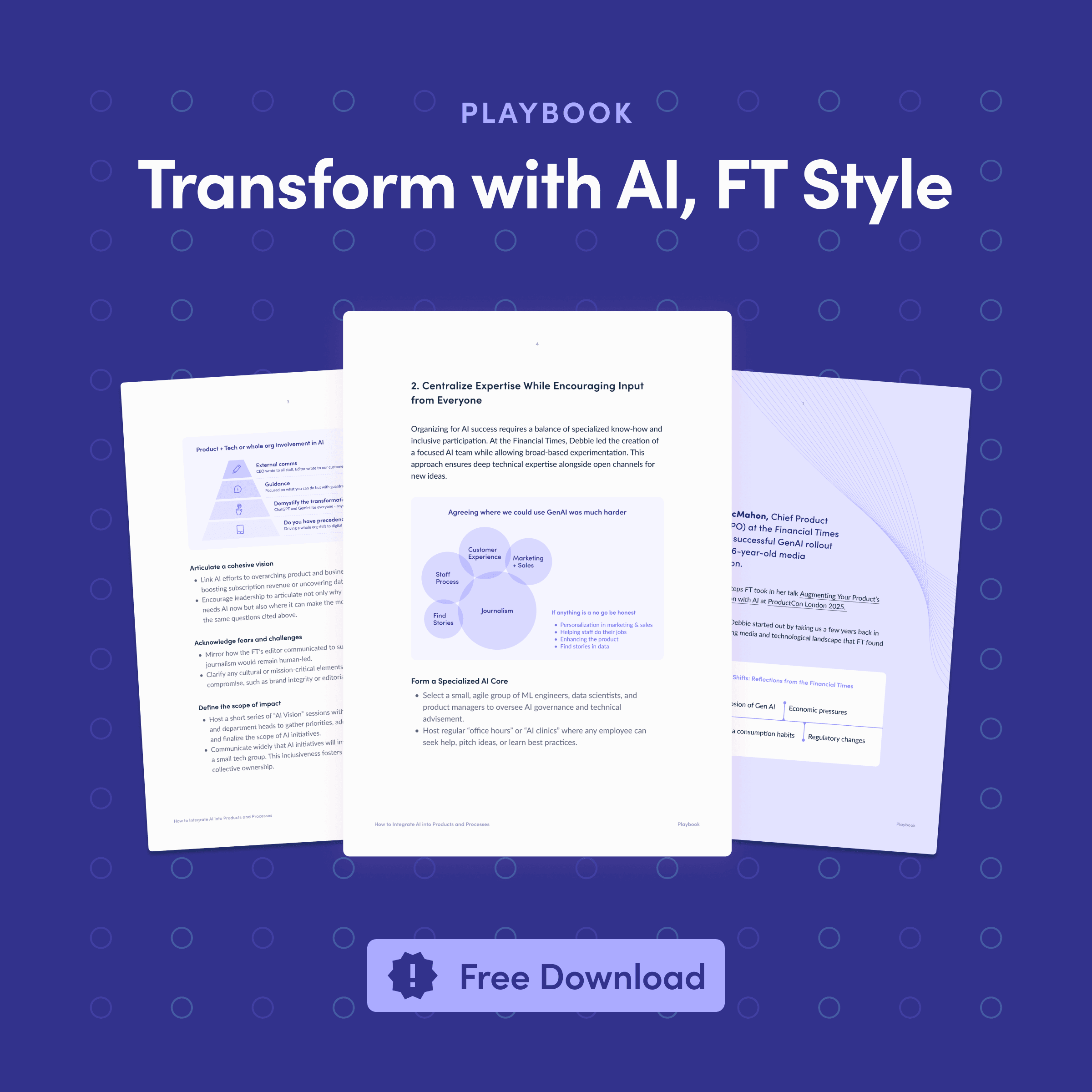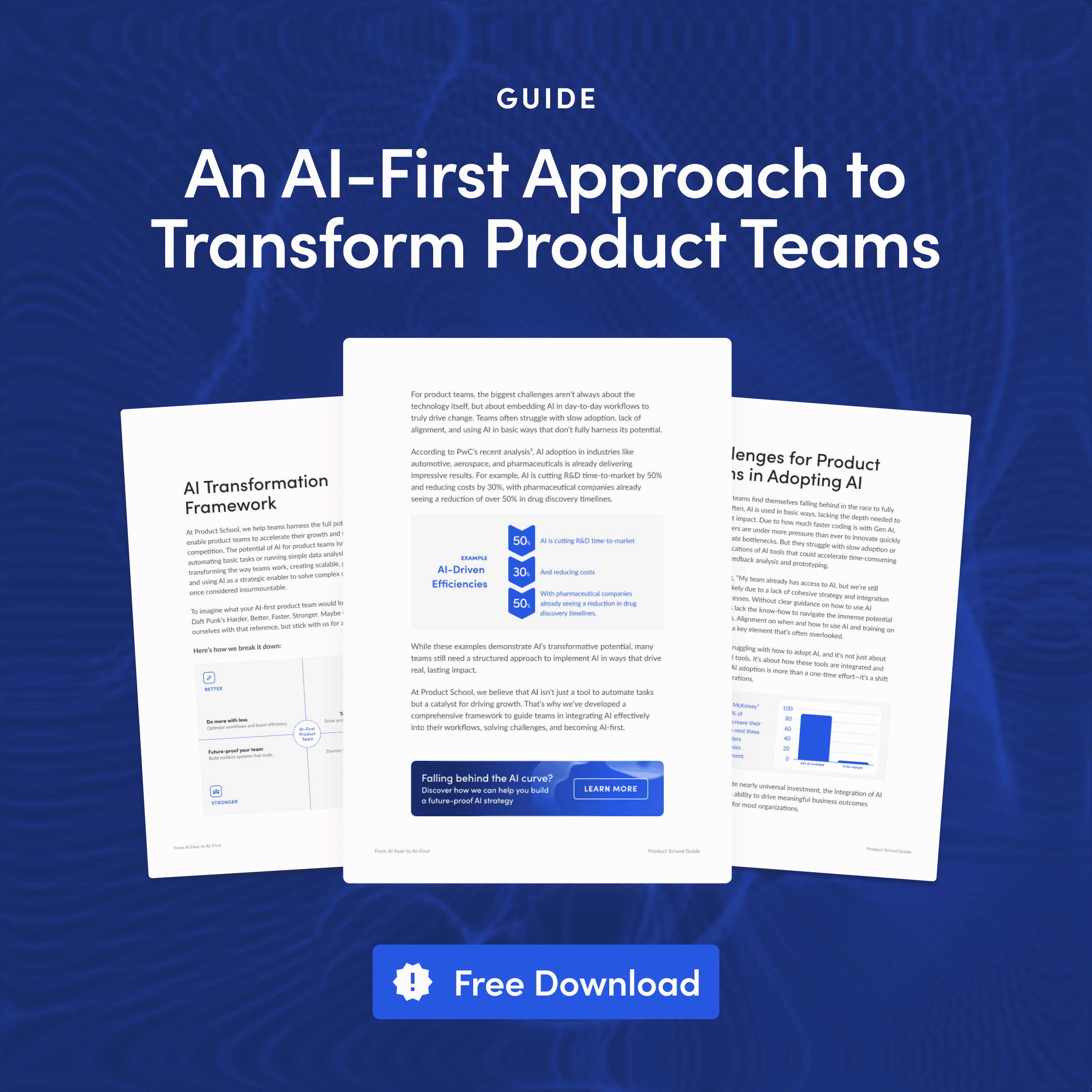Updated: September 24, 2025- 17 min read
AI isn’t just powering flashy consumer products. At this point, AI implementation is reshaping how organizations operate from the inside out. This is real work: routine approvals, data wrangling, and workflow decisions handled by algorithms that see patterns humans might miss.
According to McKinsey, 78 % of organizations now use AI in at least one business function. That’s not hype — it's part of the infrastructure. If product teams aren’t paying attention, they’re missing the transformation happening beneath the surface.
In this article, we’ll break down what AI-powered business process automation really means, dive into real-world AI use cases, and explore how product leadership can leverage these shifts to drive smarter, faster, more reliable outcomes.
Integrate AI into Products and Processes
Get insights on AI product implementation from the CPO at Financial Times, Debbie McMahon
GET THE PLAYBOOK
What Business Process Automation with AI Really Means
AI in business process automation (AI-BPA) refers to the use of artificial intelligence to streamline, manage, and improve business processes. While traditional business process automation (BPA) focuses on predefined rules and repetitive task execution, AI-BPA takes it a step further. It brings in data-driven decision-making, adaptability, and learning over time.
Instead of just following a script, AI-powered automation can analyze patterns, make predictions, adapt to changing conditions, and even optimize processes alongside or without human input. This opens the door for automating more complex, variable, and judgment-based tasks that were previously out of reach.
Teams that prioritize AI product strategy, are already well on their way in utilising AI-BPA. Let’s break it down.
The key difference between BPA and AI-BPA
Traditional BPA relies on structured logic—“if this, then that.” It’s great for rules-based systems where inputs and outcomes are predictable.
AI-BPA, on the other hand, introduces machine learning, natural language processing (NLP), and other AI capabilities into the mix. This means automation can now:
Learn from historical data to make predictions
Interpret unstructured data like emails, PDFs, or audio
Make dynamic decisions with agentic AI based on real-time inputs
Continuously improve performance over time
In short, AI allows automation to evolve from a static set of rules into a more intelligent, responsive system.
The foundational pillars of AI-driven automation
To understand how AI fits into business process automation, it helps to zoom in on the core building blocks:
Machine Learning (ML): Enables systems to learn from data, recognize patterns, and make predictions or decisions without being explicitly programmed.
Natural Language Processing (NLP): Allows systems to interpret and respond to human language, making it possible to automate things like customer emails, support tickets, or document parsing.
Computer Vision: Useful in industries like manufacturing or logistics, where visual inspection or pattern recognition is needed to automate tasks.
Intelligent Document Processing (IDP): Combines ML and NLP to extract, classify, and validate data from unstructured sources like invoices, contracts, or reports.
Decision Intelligence: The layer that helps AI-BPA systems decide what to do next based on data, probabilities, and defined outcomes.
AI Agents: Refers to AI systems that operate autonomously toward goals, often across multiple steps or tools. These agents can trigger workflows, query databases, and adapt actions based on real-time feedback. This makes them ideal for orchestrating more complex business processes.
Process Mining: Uses system logs and event data to visualize how processes actually work in practice, not just how they’re documented. This insight is essential for identifying inefficiencies and designing automation that delivers real value.
Key enablers of AI for business automation
It’s not just about algorithms. For AI-BPA to work, several underlying factors need to be in place:
A clean, well-structured data foundation
Integration with core systems (ERPs, CRMs, etc.)
Well-mapped processes that are visible and measurable
A feedback loop for continuous learning and optimization
Governance structures to ensure compliance and transparency
AI doesn’t automate or resolve the chaos in some magical way. It enhances processes that are already well understood and structured, or at least capable of being structured with some additional effort.
Examples of where AI business automation enhances traditional automation
Customer service workflows: AI can classify tickets, suggest replies, and escalate only when necessary.
Invoice processing: IDP extracts key fields, checks for errors, and routes for approval.
Sales operations: AI prioritizes leads, recommends follow-ups, and automates email outreach.
HR onboarding: Chatbots handle FAQs, while ML monitors patterns in onboarding compliance.
IT service management: AI identifies incident patterns and automates resolution paths.
The Advantages and Real-World Applications of AI in Business Process Automation
AI-automated business process is about creating smarter systems that adapt, improve, and scale with the business. For product teams, it unlocks a new layer of strategic capability — freeing up people to focus on higher-value work, improving reliability, and enabling faster iteration across the board.
Let’s look at the key advantages first.
The core advantages of AI-driven automation
1. Automating complexity, not just repetition
Traditional automation is great at repetitive, rule-based tasks. But most business product development processes aren’t that clean. They involve exceptions, edge cases, and context.
AI allows you to automate tasks with more variability. Think of interpreting an email, spotting an anomaly in a financial report, or adapting a workflow based on real-time changes.
2. Decision-making at machine speed
AI models can evaluate massive datasets in seconds, identify optimal actions, and execute them without delay. This compresses decision cycles across everything from product pricing and routing to fraud detection and lead qualification, especially useful in real-time, high-volume environments.
3. Cost efficiency at scale
Once trained, AI tools don’t scale linearly like headcount. Whether they're processing 100 or 100,000 transactions, the marginal cost of automation is nearly zero.
This makes AI a force multiplier for operations, especially in growth-stage companies looking to scale without bloating overhead.
4. Better resource allocation
When AI takes over the repetitive and administrative load, product managers, product designers, and engineers can focus on the work that actually drives product innovation — product discovery, user research, prototyping, and product strategy.
Teams move faster because they’re no longer buried in status updates, approvals, or manual data work.
5. Continuous improvement through feedback loops
Unlike static automation, AI systems can learn and adapt. For instance, a model that routes support tickets today might refine its routing logic tomorrow based on agent feedback or resolution time. This means processes can get more accurate and efficient over time with or without human intervention.
6. Enhanced customer and user experiences
AI can tailor interactions based on behavior, context, and preferences. This can be routing a customer to the right support channel or dynamically adjusting a user onboarding flow. In many cases, this leads to faster response times, more relevant outputs, and ultimately, happier users.
Real-world applications across business functions
Let’s go beyond theory. Here’s how organizations are using AI-BPA across real domains:
Finance and accounting
Invoice and expense management: AI reads and validates invoices, categorizes them, matches them with purchase orders, and flags anomalies.
Forecasting and planning: AI models analyze historical financial data, seasonality, and market trends to generate dynamic forecasts.
Fraud detection: Machine learning systems flag unusual transactions or behavior patterns, often catching fraud earlier than rule-based systems.
Customer support and experience
Intelligent ticketing: NLP engines read incoming support requests, determine intent, urgency, and sentiment, and route tickets automatically.
AI-powered chatbots and voice agents: These handle Tier 1 queries with high accuracy, reducing load on human agents.
Sentiment analysis: AI tracks tone and feedback across channels (email, chat, NPS surveys) to identify trends and proactively flag issues.
Sales and marketing operations
Lead scoring and routing: Predictive models assess lead quality based on behavioral and demographic data, and route them to the right sales reps.
Email campaign optimization: AI determines the best send times, subject lines, and content variations for specific segments.
Revenue attribution: Algorithms analyze the full customer journey across touchpoints to assign accurate credit to each channel.
Human resources
Candidate screening: AI can review CVs, match candidates to job descriptions, and prioritize high-fit applicants.
Employee retention models: Predictive analytics identify at-risk employees and surface interventions early.
Onboarding workflows: Automated systems tailor onboarding experiences based on location, role, and department needs.
Product and engineering teams
Bug triage: AI agents classify, prioritize, and even assign issues to the right engineers based on past issue data.
Automated testing: AI-driven QA tools generate test cases and detect UI or functionality anomalies.
User feedback analysis: NLP tools analyze app reviews, support tickets, and survey responses to uncover feature gaps or friction points.
Legal and compliance
Contract review: NLP models extract and summarize contract terms, highlight risks, and compare clauses to company policy.
Regulatory monitoring: AI tools scan regulatory databases and news sources to track emerging compliance risks.
Audit trail automation: Every AI-driven process can be logged and explained, creating traceability for compliance.
AI agents: a rising application layer
We’re now seeing a growing role for agentic AI systems that can autonomously complete multi-step workflows based on a goal or prompt. For example:
A customer success agent who monitors churn signals, reaches out with renewal offers, and escalates when necessary.
An internal tooling agent that pulls product metrics, writes a weekly report, and emails it to the right stakeholders.
A QA agent that reads sprint updates, identifies missing tests, and assigns tasks in Jira.
These AI agents are augmenting workflows. For product teams already deep into orchestration tools like Zapier, N8N, Make, or Workato, this is the next frontier: agents making independent decisions across steps.
Trends, Predictions, and the Future of AI for Business Processes
Business process automation has always been about efficiency, but AI is turning it into something much more dynamic: a system that learns, adapts, and even reasons. As AI capabilities mature, the way businesses approach automation is evolving rapidly. The shift isn’t just technical—it’s strategic.
Here’s a deep dive into the trends driving this evolution, what’s coming next, and how product leaders should be thinking about it.
Current trends shaping automation using AI
1. The rise of no-code/low-code AI tools
AI-BPA used to be reserved for product teams with strong AI data analytics, data PM, product analytics, or machine learning capabilities. That’s changing.
Tools like Microsoft Power Automate with Copilot, and OpenAI’s GPT integrations into enterprise platforms are making AI accessible to non-technical teams. Product managers can now build AI-enhanced workflows without writing a line of code.
This democratization of AI means automation is no longer a back-office project. It’s becoming a product capability, shaping how product teams operate and how users interact with systems.
2. Shift from task automation to outcome automation
Organizations are moving beyond automating isolated steps (like tagging a ticket) to automating toward OKRs (like increasing ticket deflection or reducing cycle time). This means chaining multiple AI components — IDP, decision engines, LLMs — into cohesive workflows that drive real impact.
It’s not just “Can we automate this task?” but “Can we trust AI tools to drive this process toward a goal?”
3. Integration with product-led systems
AI is increasingly embedded within customer-facing products and internal tools. For this reason, the lines between “product” and “process” are blurring.
For product teams, this means AI-BPA is about internal ops just as much as it is about shaping UX, accelerating onboarding, and unlocking self-serve product experience.
4. Adoption of agentic workflows
Thanks to advances in large language models and orchestration frameworks, we’re seeing real-world deployment of AI agents. These are the systems that take multi-step actions across tools to achieve, say, a product goal. These agents are being used for everything from drafting reports to coordinating recruiting pipelines.
Companies are now experimenting with giving agents long-term memory, the ability to use APIs, and access to real-time feedback. These are all key ingredients for more autonomous, adaptive process automation.
5. Process mining as a precondition for AI automation
Before AI can optimize a process, you have to understand how it works today. Process mining tools like Celonis and IBM Process Mining are being used to map and analyze how work actually flows across systems, exposing friction points and gaps.
This kind of diagnostic insight is becoming a core part of AI-BPA strategies. It helps teams avoid automating broken processes and ensures automation aligns with actual usage patterns.
Predictions: What’s next for AI-BPA?
1. Domain-specific AI copilots will become standard
We’ll move from generalized chatbots to deeply integrated AI copilots in every function: finance, HR, legal, product management, support. Keep in mind that these copilots take action. They’ll be trained on company-specific processes, policies, and systems.
Think of an AI financial analyst that prepares variance reports, flags anomalies, and recommends budget reallocations, before you ask.
2. Human-AI collaboration will become more orchestrated
Instead of replacing humans, AI will sit in the middle of workflows— proposing, nudging, completing. Humans will shift from “doing” to “supervising and steering.” Think of it like a cockpit. AI handles altitude and navigation, but a human still steers the mission.
This will require better interfaces, clearer explainability, and stronger trust mechanisms, especially in regulated industries.
3. Regulatory pressure will shape how AI-BPA is deployed
As global regulations take hold, companies will need to ensure their AI automations are auditable, explainable, and compliant. Shadow AI, tools deployed without oversight, will become a risk.
Enterprise-ready AI-BPA will need version control, bias detection, governance dashboards, and human-in-the-loop options.
4. End-to-end autonomous processes will emerge (selectively)
In specific domains like logistics, invoice processing, or IT ticketing, we’ll see AI systems managing entire flows with minimal human input. But full autonomy won’t be everywhere. Most processes will settle into semi-automated states, where AI handles 70–90% of the work, and humans jump in for exceptions.
As Dave Bottoms, the GM and VP of Product at Upwork puts it on our Product Podcast:
We're interestingly a long way from AI replacing people, but AI doing 50, 60, 70 % of the work and then the people coming in to refine, customize, augment. You're getting a working product… much more quickly and efficiently.
The future seems to invite selective delegation, optimized by prioritization frameworks and exception handling.
5. Product-led automation will reshape how teams scale
Startups and scale-ups are increasingly building automation into their product infrastructure from day one. Instead of hiring ops teams, they’re building internal platforms powered by agents, APIs, and AI logic.
This shift turns automation from a cost-saving measure into a growth enabler. It allows small teams to punch above their weight — shipping faster, learning faster, and operating leaner.
Where we’re headed: The strategic shift
The biggest shift isn’t technological—it’s philosophical. I know this sounds a bit woo-woo, but hear me out.
In the past, automation was something you tacked on. Now, it’s something you design for.
AI product managers are being asked to think not just about features and user flows, but also about how the systems under the hood work intelligently and autonomously.
This means:
Designing products that learn from users and optimize themselves
Building internal workflows that are agent-friendly and API-first
Equipping teams with the skills to supervise and shape AI behavior
The question for product leaders isn’t “Should we automate this?” but “Where can AI give us a structural advantage?”
Recommended AI Tools for Business Process Automation
There’s no one-size-fits-all solution when it comes to AI-powered automation. The right tool depends on your team’s size, technical skills, existing systems, and how complex your workflows are.
Here’s a curated list of top AI business process automation tools—each with strengths in different areas.
UiPath One of the leaders in robotic process automation (RPA) with built-in AI capabilities. UiPath lets you automate structured and semi-structured tasks across systems like SAP, Salesforce, and Excel. With the new Autopilot feature, users can create automation workflows using natural language prompts, making it accessible for non-technical roles.
Zapier Perfect for product teams and startups. Zapier connects 6,000+ apps and automates workflows using a simple trigger-action model. Its new AI-powered Zap Builder lets you describe what you want to automate and it builds the workflow for you. Great for marketing ops, CRM updates, notifications, and internal tool integrations.
Make A visual automation platform with more flexibility than Zapier. Make is ideal for more complex, multi-step workflows that involve conditions, loops, and branching logic. It's widely used by product ops, RevOps, and no-code teams automating cross-functional systems.
n8n An open-source workflow automation tool for developers and technical teams who want full control. With support for conditional logic, custom JavaScript functions, and over 400 native integrations, n8n is ideal for teams building secure, self-hosted, or deeply integrated workflows. It also supports AI use cases through OpenAI and Hugging Face integrations.
Microsoft Power Automate Enterprise-ready automation that integrates natively with Microsoft 365, Dynamics, and Azure. With Copilot built in, teams can use natural language to generate flows. Especially useful for automating document workflows, approvals, notifications, and internal operations across departments.
Workato A top choice for companies with growing complexity. Workato supports enterprise-grade integrations and automation between apps, databases, and APIs. It also allows for user-specific logic, governance, and error handling. Great for product-led organizations that need to maintain data flow across customer systems, billing, and support.
Kognitos An AI-native business automation platform that executes workflows written in plain English. Unlike traditional RPA tools, Kognitos uses large language models to read, understand, and act on instructions. Ideal for teams looking to automate processes that involve email parsing, ERP interactions, and real-time approvals.
Parabola Excellent for automating and transforming spreadsheet-heavy workflows. Parabola is often used by operations and growth teams to automate data collection, cleanup, and reporting—without writing code. Think of it as “Excel meets automation meets APIs.”
Aisera Focused on AI service management. Aisera uses conversational AI to resolve IT tickets, HR requests, and customer support queries autonomously. It integrates with systems like ServiceNow and Salesforce and can reduce ticket volume significantly while improving resolution speed.
Celonis This is a process mining and execution management tool. Celonis helps companies see how work actually happens across systems using real-time data. From there, it recommends or automates optimizations using AI. It’s especially useful before implementing automation—so you know what to automate and why.
Relevance AI Built for teams that need to analyze unstructured data at scale. It lets you cluster, classify, and visualize data using LLMs and embeddings. Product and operations teams use it to automate tagging, insight extraction, and decision support in workflows involving support tickets, user reviews, or qualitative research.
Making the Most of AI in Business Process Automation
Most teams don’t need more tools but better systems. AI won’t fix broken processes. So if your workflows are already messy, layering AI on top will just make them faster… at breaking things.
The real opportunity with AI in business process automation isn’t to automate everything. It’s to automate the right things — the repetitive, error-prone, decision-heavy tasks that slow teams down and distract from meaningful work.
The teams who win with AI are building with intention. They know where their bottlenecks are. They’re clear about which processes need control and which ones are safe to delegate to machines. And they design for AI from the ground up.
So what about not starting with “What can we automate?”
What about starting with what Trisha Price, the CPO at Pendo, points out on The Product Podcast:
We revisited what are the hardest problems that our customers need solved where AI could play a role... What takes too long? What's too hard?... Utilize knowledge bases that you've already created and make that really fast.
Then use AI not to replace people, but to protect their time, so they can focus on what actually moves the product forward. That’s the real value of AI-BPA. Not flash. Just leverage.
Level up on your AI knowledge
Based on insights from top Product Leaders from companies like Google, Grammarly, and Shopify, this guide ensures seamless AI adoption for sustainable growth.
Download Guide
Updated: September 24, 2025





